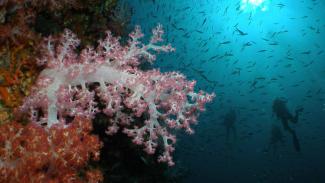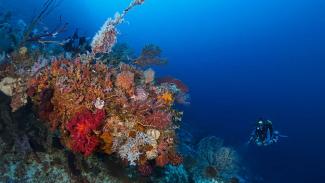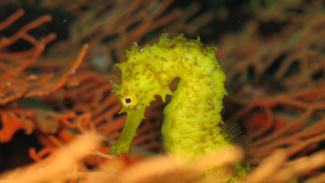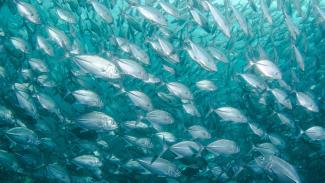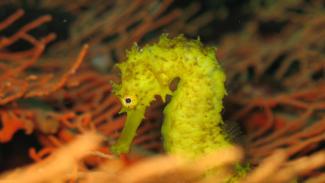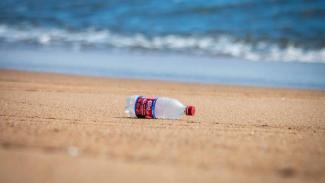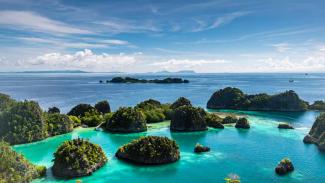
The underwater world of South-East Asia has long been famed for its wealth & diversity of marine life. But it is only relatively recently that scientists have begun to get a hold on just how diverse and special the area is.
Their research has led to the birth of the Coral Triangle - an area encompassing Indonesia, Malaysia, the Philippines, Papau New Guinea & the Solomon Islands - that has been identified as the most diverse marine ecosystem on our planet.
A biological wonderland
Coral Reefs worldwide cover only 0.02% of the world's oceans, yet they are vitally important. Despite their relatively tiny area, they support a quarter of the world's marine species, while 500 million people rely on the reef's resources for their livelihoods. Millions more of us benefit from their wealth of treasures, primarily through food and tourism.
The Coral Triangle is the epi-centre for this diversity - the engine room of the marine world. Within its boundaries are over 600 species of reef-building corals, which are vital to the future health of coral reefs & their residents. This amounts to 75% of the world's total. As a gauge to its diversity, the whole of the Caribbean has just 60 species of coral.
Remarkable Residents
The triangle is not only special for its corals. The reefs and their surrounding waters support: over 3000 different species of fish; 6 of the world's 7 turtle species, providing nesting grounds for five of these species; three-quarters of known Molluscs, (such as Octopus & Squid); 22 species of Dolphin; at least 9 species of Whale; the endangered Dugong; many Manta Rays & Whalesharks and even the Coelacanth - an ancient fish that pre-dates even the mighty Dinosaurs.
In addition, 75% of the world's mangrove species are found in the triangle, along with 45% of sea-grasses - both vital habitats for Turtles, Dugongs and countless juvenile marine species..... and all in an area that makes up just 1% of the world's oceans.
A Stable Past
The first question you may ask is, how did this area become such a bio-diversity hotspot? Why does this area, as opposed to any other area of the world, have such an unrivalled variety of life?
The answer lies in the area's past. Through-out it's history, while other marine habitats have been frozen in ice during ice ages or left high and dry by falling sea levels, this area of the world remained mostly underwater. As a result, marine life has been allowed to evolve unhindered.
Added to that, while other areas of the world drifted from the equator - to temperate and even polar regions as a result of plate tectonics, this area remained near the tropics in warm, clear water - which provide the perfect environment for coral reefs - the most productive and diverse of all habitats on earth.
This continued stability and ideal conditions over millions of years has created a biological wonderland we are only now beginning to understand and appreciate - the famed Coral Triangle.
The Coral King
Over recent years, a number of areas have held the title of the world's most diverse marine habitat, but currently, that title is held by Raja Ampat. This group of islands, consisting of four main islands, around 1,500 smaller islets and 2,500 reefs, can be found on the western tip of Western Papua, formerly known as Irian Jaya. Aptly, the translation of Raja Ampat is 'four kings', a name given to the area when it was granted to four kings by a sultan of the famed Spice Islands many centuries ago.
This relatively small, remote area in the Halmahera Sea has 600 coral species, 700 Molluscs & more than 1,200 species of fish. Nutrient rich currents feed the reefs and its inhabitants, which have remained relatively free from human interference due to their remote location. As a result, the numbers and variety of species is simply bewildering - a true king of kings.
A fragile future
Leading Lights
There are a number of organisations & individuals that are working tirelessly to reduce these threats and preserve the coral triangle. Conservation International, The Nature Conservancy & the World Wildlife Fund are working with individuals, communities and governments to bring about change. There are also smaller, less well-known organisations, such as Project Seahorse in the Philippines, who do a fantastic job to raise awareness and change cultures and practices.
'
One of the initiatives that is being set up is the creation of a wide-ranging network of Marine Protected Areas, or 'no take' zones. Creating areas where no fishing at all is allowed has been proven to have significant benefits for the surrounding areas in terms of healthy fish populations. Schemes that are well-managed are bringing significant benefits to local communities, encouraging other communities, with the help of Governments and Conservation Agencies to follow their lead.
A Coral Triangle Initiative has been created, involving all six countries that form part of the coral triangle, plus conservation agencies and some (but not enough) western governments. This Initiative has established a governing body for the area, a team of experts to study and monitor the region, and a rapid alert system to respond quickly and effectively to threats to the triangle.
Conservation organisations are working hard to promote sustainable, non destructive fishing practices within coastal and offshore fisheries to create a well-managed, sustainable industry, especially for aqua-culture and tuna - two of the most valuable industries of the region. Work is also being done to protect turtle nesting, foraging and migratory routes and habitats and promote alternative fishing techniques that are less harmful to turtles.
They are also lobbying governments and organisations to force action to reduce the effects of climate change.
Making a Difference
Still more needs to be done though. More money is needed, as is more awareness of the area's riches and threats. More pressure needs to be put on those in power to prioritise the area and implement solutions.
And you can help too. Supporting the many aid agencies in the area (see the list below), volunteering to work on crucial projects and lobbying your local government to do more are three ways in which your help can be invaluable. It is possible to protect the area's bio-diversity, but to do this, we need to work together..... and today.
You might also enjoy...
The seas of Asia
Asia is caught between two huge oceans, the Indian Ocean to the west and the Pacific to the east. In between is a complex geography of land & water that has given rise to some of the most fascinating & species rich seas on our planet.
Getting technical
Christian Gloor
Have you ever found yourself diving on a reef wall and wondering what lurks in the depths below? Or longed to spend more than a few fleeting moments exploring a mysterious & historic shipwreck?
Then maybe technical diving is the sport for you. Increasing numbers of divers, eager to explore beyond the bounds of recreational limits, are taking an interest in technical diving.
Conservation matters
With almost 100,000 sq km of coral reefs, 51 different species of mangrove and 23 species of sea-grass, South-east Asia supports the most diverse collection of life on earth.
Unfortunately, this kaleidoscope of life may be on the brink of collapse. The consequences of human activity are putting pressure on this environment & its inhabitants every day, with south-east Asia's reef considered to be the most threatened on earth.
Current affairs
Every diver has had experience dealing with currents - in some way they affect every single dive we make. Sometimes they are in our favour, providing a delightful drift dive.
Other times, they turn against us, making a dive difficult & strenuous. They have a big impact on marine life too, bringing nutrients that feed entire communities, from the corals themselves up to mighty Whalesharks.
Asia's endangered species
Tara North
Asia is home to some of the most diverse habitats in the world, both above and below the water, but it is estimated that more than one in three species are endangered... and the figure is rising alarmingly fast.
Underwater, a whole range of pressures are putting marine life under immense pressure. Intense population pressure is leading to over-fishing, pollution and the destruction of crucial habitats.
Get Involved
Brian Yurastis


